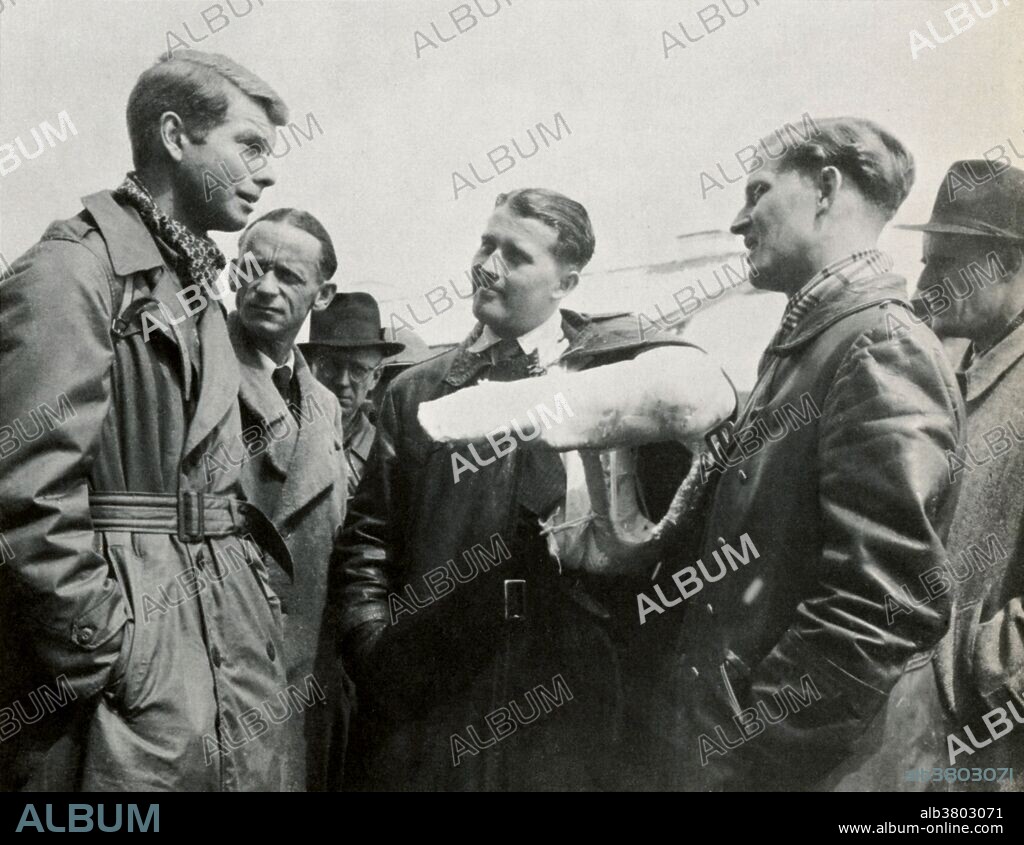alb3803071
Werner von Braun Surrenders, 1945

|
Add to another lightbox |
|
Add to another lightbox |



Title:
Werner von Braun Surrenders, 1945
Caption:
Werner von Braun (with arm in cast) surrenders to the Americans at Reutte, in May 1945. Left to Right are Charles L. Stewart, U.S. counter-intelligence agent; Lt. Col. Herbert Axter, attached to Gen. Dornberger's staff' Dieter K. Huzel; Wernher von Braun; Magnus von Braun and Hans Lindenberg.Wernher Magnus Maximilian, Freiherr von Braun (March 23, 1912 - June 16, 1977) was a German-American rocket scientist, aerospace engineer, space architect, and one of the leading figures in the development of rocket technology in Nazi Germany during World War II and, subsequently, in the United States. He was the central figure in Germany's rocket development program, responsible for the design and realization of the V-2 combat rocket during World War II. After the war, he and select members of his rocket team were taken to the United States as part of the then-secret Operation Paperclip. Von Braun worked on the United States Army intermediate range ballistic missile (IRBM) program before his group was assimilated by NASA. Under NASA, he served as director of the newly formed Marshall Space Flight Center and as the chief architect of the Saturn V launch vehicle, the superbooster that propelled the Apollo spacecraft to the Moon. His crowning achievement was to lead the development of the Saturn V booster rocket that helped land the first men on the Moon in July 1969. In 1975 he received the National Medal of Science. He died of pancreatic cancer in 1977 at the age of 65.
Credit:
Album / Science Source / New York Public Library
Releases:
Model: No - Property: No
Rights questions?
Rights questions?
Image size:
3807 x 2943 px | 32.1 MB
Print size:
32.2 x 24.9 cm | 12.7 x 9.8 in (300 dpi)
Keywords:
1945 • 1977 • 20 XX TWENTIETH CENTURY • 20TH CENTURY • 20TH • AEROSPACE ENGINEER • AEROSPACE • ASTRONAUTICS • BRAUN • BW • CELEBRITIES • CELEBRITY • FAMOUS PEOPLE • FAMOUS • FIGURE • FREIHERR VON BRAUN • GERMAN-AMERICAN • GERMAN-BORN • HISTORIC • HISTORICAL • HISTORY • IMPORTANT • LIQUID FUELED ROCKET • MALE • MAN • MEN • NASA • NATIONAL MEDAL OF SCIENCE • NAZI GERMANY • NOTABLE • OPERATION PAPERCLIP • PEOPLE • PERSON • PERSONALITIES • PERSONALITY • PHOTO • PHOTOGRAPH • PORTRAIT • POTRAIT • ROCKET SCIENCE • ROCKET SCIENTIST • ROCKET TECHNOLOGY • SATURN V BOOSTER ROCKET • SATURN V LAUNCH VEHICLE • SAVANT • SCIENCE • SCIENTIFIC • SCIENTIST • SPACE ARCHITECT • SPACE EXPLORATION • SPACE PROGRAM • SPACE TRAVEL • SURRENDER 1912 • TWENTIETH CENTURY • V-2 COMBAT ROCKET • VON BRAUN • WAR • WELL-KNOWN • WERNER VON BRAUN • WERNHER MAGNUS MAXIMILIAN VON BRAUN • WERNHER MAGNUS MAXIMILIAN • WERNHER VON BRAUN • WORLD WAR 2 • WORLD WAR II • WORLD WAR TWO • WW II • WWII
 Pinterest
Pinterest Twitter
Twitter Facebook
Facebook Copy link
Copy link Email
Email

